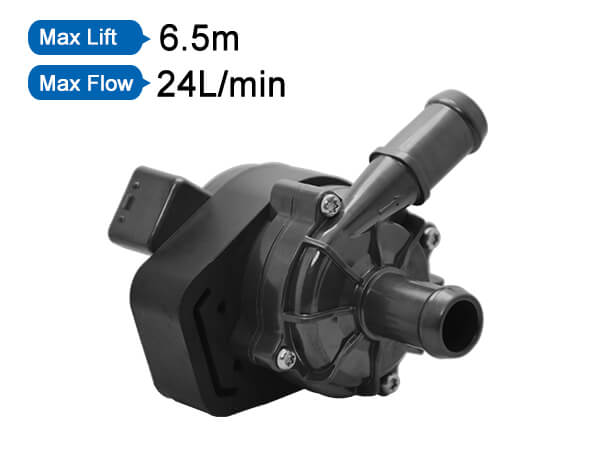Circulating Water Pumps in Electric Vehicles: Roles, Requirements & Applications
Published:2025-08-08

I. The Key Role of Circulating Water Pumps in Thermal Management Systems
In the thermal management system of new energy vehicles, the circulating water pump plays the core role of a "blood transporter". The power batteries and motors of new energy vehicles generate a large amount of heat during operation. If the heat cannot be dissipated in time, it will lead to reduced battery performance, shortened service life, and even potential safety hazards. In low-temperature environments, it is necessary to heat the batteries and motors to ensure their normal operation. The circulating water pump drives the coolant to circulate in the closed pipeline system, transferring heat from high-temperature components (such as battery packs and motor controllers) to the radiator to achieve efficient heat dissipation. In heating mode, it can also transport heat from heat sources (such as heat pumps and electric heaters) to components that need to be warmed up.
In addition, precise temperature control is crucial for the range and performance of new energy vehicles. Shenpeng circulating water pumps can dynamically adjust the flow rate of coolant according to the vehicle's real-time working conditions and temperature requirements, ensuring that all key components are always in the optimal operating temperature range. For example, during fast charging, the battery generates heat sharply, and the circulating water pump will automatically increase its speed, increase the coolant flow rate, quickly take away excess heat, and ensure the safety and charging efficiency of the battery.
II. Special Requirements for Circulating Water Pumps in Different Types of New Energy Vehicles (Pure Electric, Hybrid, Fuel Cell)
(I) Pure Electric Vehicles
Pure electric vehicles rely entirely on power batteries for power, and the performance of the batteries directly determines the vehicle's range and power performance. Therefore, pure electric vehicles have extremely high requirements for the battery thermal management system, and correspondingly, put strict standards on circulating water pumps. Firstly, since pure electric vehicles have no waste heat generated by the engine for utilization, in low-temperature environments, the circulating water pump needs to efficiently transport the heat generated by the electric heater to the battery pack to improve battery activity. This requires the water pump to have good low-temperature adaptability, being able to start and operate normally in an ambient temperature of -30°C or even lower without affecting the flow rate and head performance.
Secondly, the battery capacity of pure electric vehicles is relatively large, and more heat is generated during charging and discharging. The circulating water pump needs to have a higher flow rate and head to meet the demand for rapid transfer of large amounts of heat. At the same time, in order to reduce the impact on the vehicle's range, the circulating water pump must have excellent energy-saving characteristics, minimizing power consumption while meeting the heat dissipation requirements.
(II) Hybrid Electric Vehicles
Hybrid electric vehicles have both a fuel engine and a power battery system, and their thermal management systems are more complex. The circulating water pump needs to coordinate the heat management of multiple heat sources. During vehicle operation, the circulating water pump is not only responsible for reasonably distributing the waste heat generated by the engine for preheating the engine, heating the interior space, or assisting in battery heating, but also for handling the heat generated by the power battery and motor.
This requires the circulating water pump to have flexible flow regulation capabilities, being able to quickly switch working modes according to different working conditions of the engine and battery to achieve precise heat distribution. For example, during the cold start phase of the engine, the circulating water pump needs to reduce the coolant flow rate to allow the engine to reach the optimal operating temperature as soon as possible; while when the battery is working under high load, the flow rate must be increased to ensure effective heat dissipation of the battery.
(III) Fuel Cell Vehicles
The core of fuel cell vehicles is the fuel cell stack, whose working process is extremely sensitive to temperature and humidity. The main task of the circulating water pump in the thermal management system of fuel cell vehicles is to maintain the stable operating temperature of the fuel cell stack and take away the excess heat generated by the reaction. Since the operating temperature range of the fuel cell stack is relatively narrow (usually 60 - 80°C), the flow control accuracy of the circulating water pump must be extremely high. A slight deviation may affect the efficiency and service life of the fuel cell.
In addition, the fuel cell reaction will generate a large amount of water vapor, and the circulating water pump also needs to cooperate with other components to participate in humidity management to prevent excessive water accumulation from affecting the performance of the fuel cell. At the same time, the working environment of fuel cell vehicles is complex and changeable, so the circulating water pump needs to have good sealing and corrosion resistance to adapt to different climates and road conditions.
- Distribution in Water Heater Mattresses: Why BLDC Pumps Ensure Uniform Heating
- How BLDC Pumps Ensure Precise Flow in Water Dispensers
- Why BLDC Pumps Are Essential for Smart Toilets
- The Critical Role of Automotive Electronic Water Pumps in New Energy Vehicle Battery Thermal Management
- Noise Control Technology for Smart Toilet Water Pumps: Enhancing Quiet Operation in Modern Bathrooms
- Unveiling the Working Principle of Automotive Electronic Water Valves
- Comparative Analysis of Liquid-Cooled Pumps vs. Air-Cooled Systems for EV Charging Stations
- Technical Application of Brushless DC Motors in Energy Storage Circulation Pumps
- Water Heater Pump: Efficiency Upgrade for Low-Voltage Systems
- How Dishwasher Water Pumps Enhance Cleaning Coverage Through Stable Operation?
